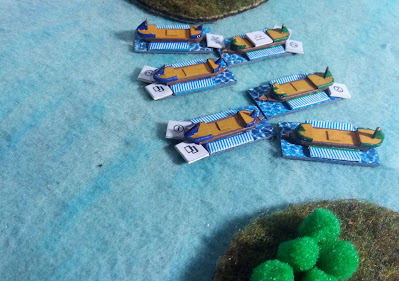I gave my new triremes for Galleys & Galleons an outing yesterday. It was a simple battle with ten identical triremes on each side. I randomised the terrain and partially randomised the setup.
All of the triremes had the following stats:
Trireme - 40pts - Q3 C3 - Galley, Ramming, Unarmed, Shallow Draft, Yare
On the left, in red and blue, is Carthage. On the right, in yellow and green, is Syracuse. Syracuse has a slight edge in that they are closer to the flank-protecting islands.
The position after a few moves. With ten ships a side it is unlikely that any group would stay together for long before rolling a couple of failures and forcing a turnover. In the foreground Syracuse had pushed forward a good sized force of ships, but further north (we'll assume that north is at the top) they hadn't made much progress in grabbing the gaps between the islands. Meanwhile Carthage was moving forward in an equally haphazard manner.
The first encounter saw archery being exchanged, but neither side quite ready to sweep in with the rams. Ramming an opponent from the front is not only less effective than coming in from the side, but also puts the ramming ship at risk of losing oars (the target is always at risk of doing so).
The first ram. A Syracusan ship (green) had broken through around the flank of the southernmost Carthaginian ships. One of them turned to meet it and rammed it amidships.
This prompted a flurry of counter-ramming, and the first proper damage of the action.
To the north both sides were bringing up ships into what now seemed to be the main fight. The Syracusans threw caution to the wind and went head to head with the Carthaginians, who started to get the worst of the fight.
To the north the two sides met in the gap with three triremes each, and were initially happy to simply exchange arrows. The Carthaginians took some hits.
An overview of the action. After an initial burst of ramming, both sides were considering whether to shoot or board.
The first casualty - a crippled Carthaginian ship was rammed and sunk.
To the north the Carthaginians decided to close and ram, with varying levels of success. Two of their ships took oar damage in the attacks.
Thanks to the evil All at Sea table, a damaged Carthaginian galley took it upon itself to strike.
However two Syracusan ships also surrendered after suffering varying levels of damage from ramming and boarding.
Another Carthaginian galley was rammed and sunk.
Both sides and now taken casualties and most ships were damaged. I'd decided that a side would quit when it lost more than half of its ships. And it was Syracuse who reached that point first, with a ship surrendering to a boarding action, pushing their losses to six out of ten vessels.
The losses. Syracuse (top) lost one trireme sunk and five surrendered/captured. The Carthaginians only had one ship surrender, but lost three sunk. Still, they effectively made a net gain of one ship at the end of it.
When I played out some ancient actions a couple of years ago, they were virtually all decided entirely by ramming. However whilst ramming was important in this action, there was a lot of archery between ships, which inflicted a few hits, and a number of boarding actions too. Both helped tip the balance; grappling a damaged ship, for example, makes it risky when it rolls activations as a bad roll can see the ship instantly surrender.
Whilst I will try this again at some stage, it will be interesting to see how the introduction of larger ships, or ones with additional abilities affects things. Also a flagship on each side would help keep things moving, even if just locally.
This was my first game of Galleys & Galleons this year, so it's another 52 Games entry.
52 Games - Game 23
















I love the look of your games, and your galleys. It makes me want to take a crack at making some myself.
ReplyDeleteThanks. They're not difficult to make.
DeleteYes, I was thinking of making some myself (or I might just buy some!) I'll have another look at the articles where you describe making them.
ReplyDeleteInteresting game Kaptain. Given there were two equal sides, what was it that really tipped the balance in the Carthaginian favour?
ReplyDeleteIt was a run of ones for the Syracusans - roll a one on a damaged activation dice when you're grappled to an enemy ship and you automatically strike. In addition if you roll a one and you're not grappled then you roll on the All At Sea Table, and a roll of one on that table can cause you to strike. The Syracusans did both. That's why most of their casualties were struck ships - the Carthaginians took more damage and losses, but didn't suffer such bad rolls.
DeleteIn other words the Syracusans won on paper, but their crews thought they'd lost and acted accordingly :)
So morale linked to luck. As Napoleon said, Morale is to the physical as three to one.
ReplyDelete